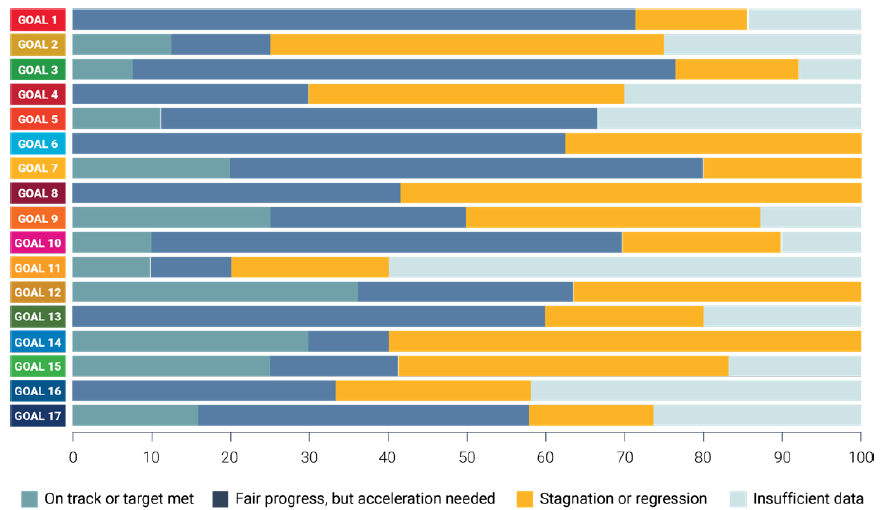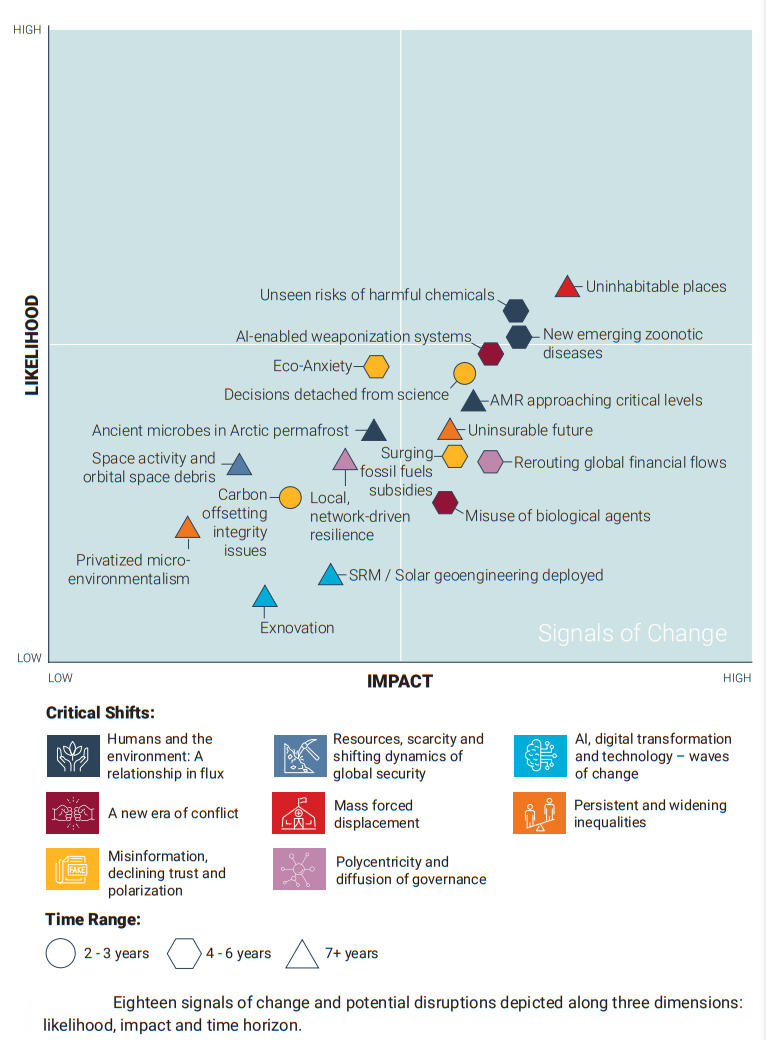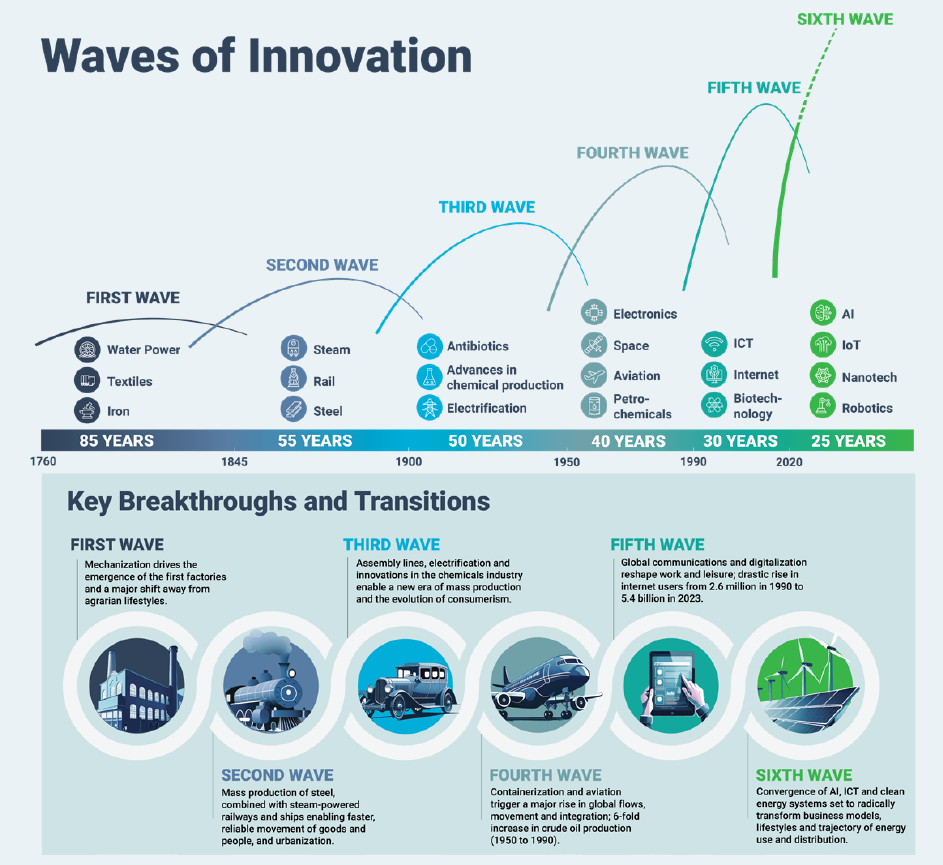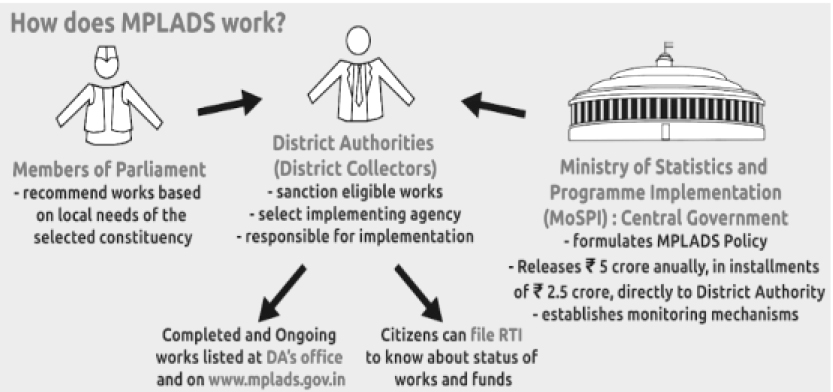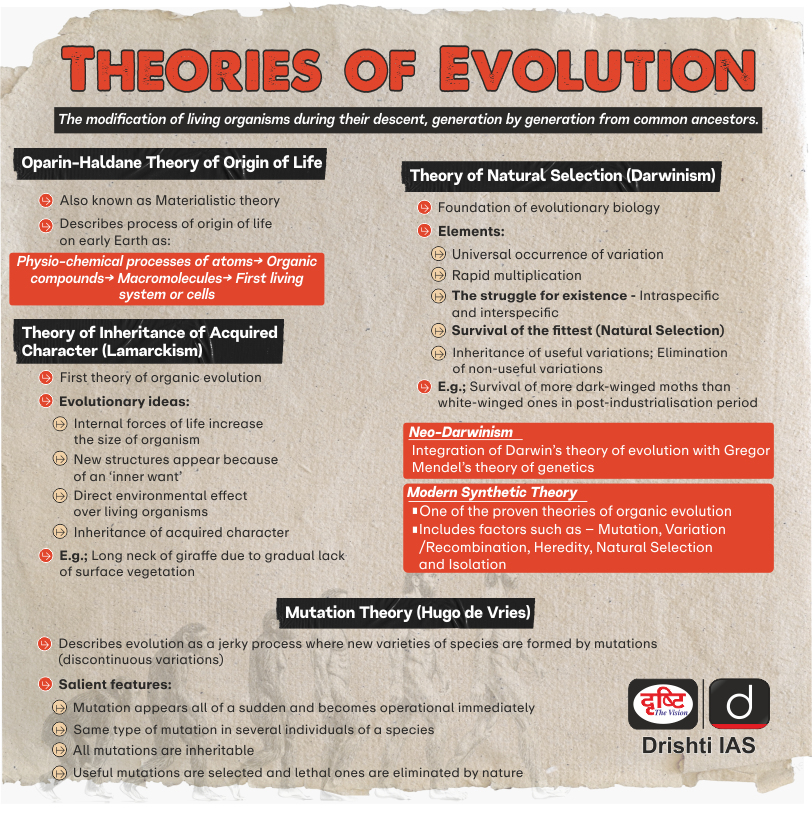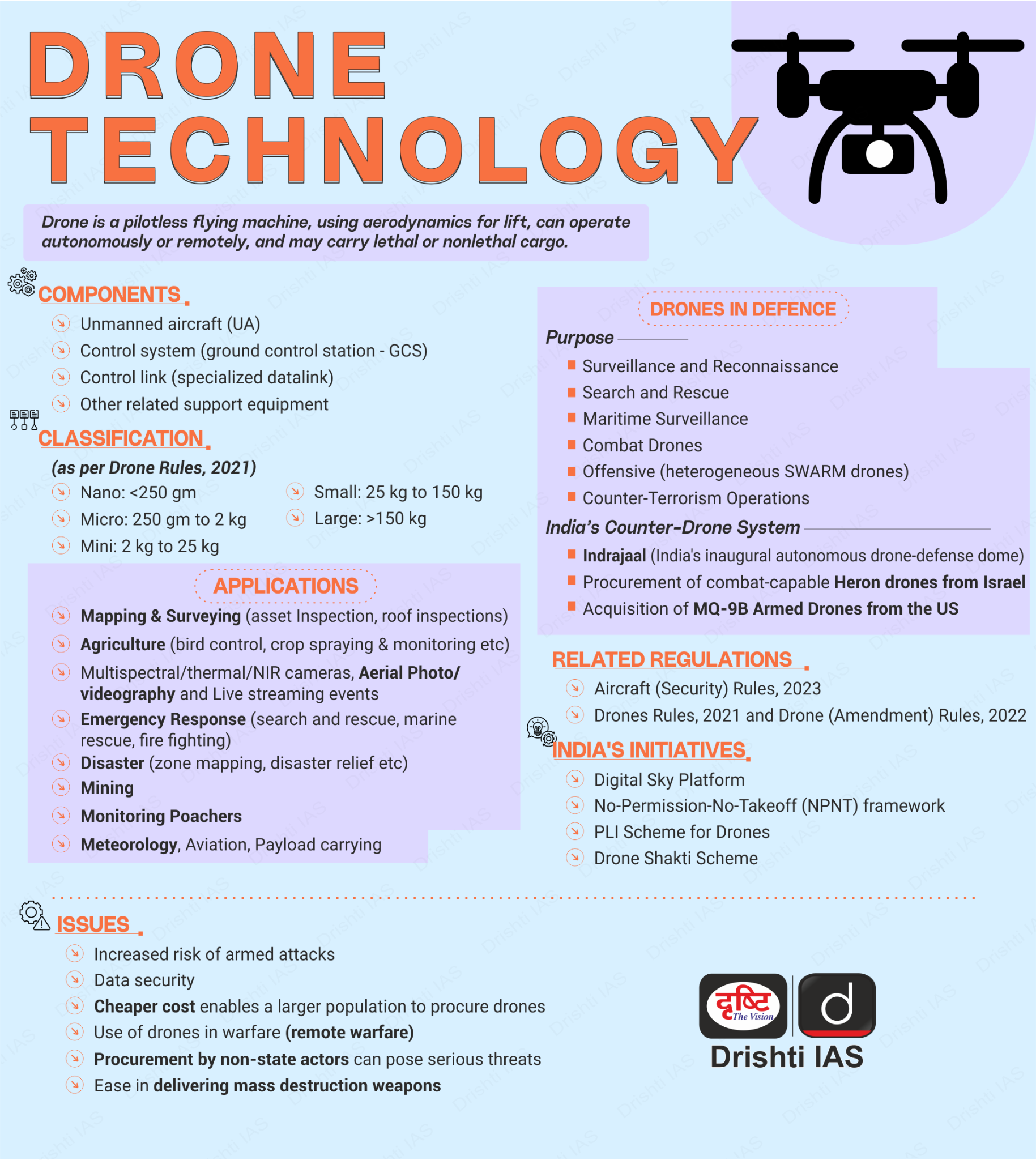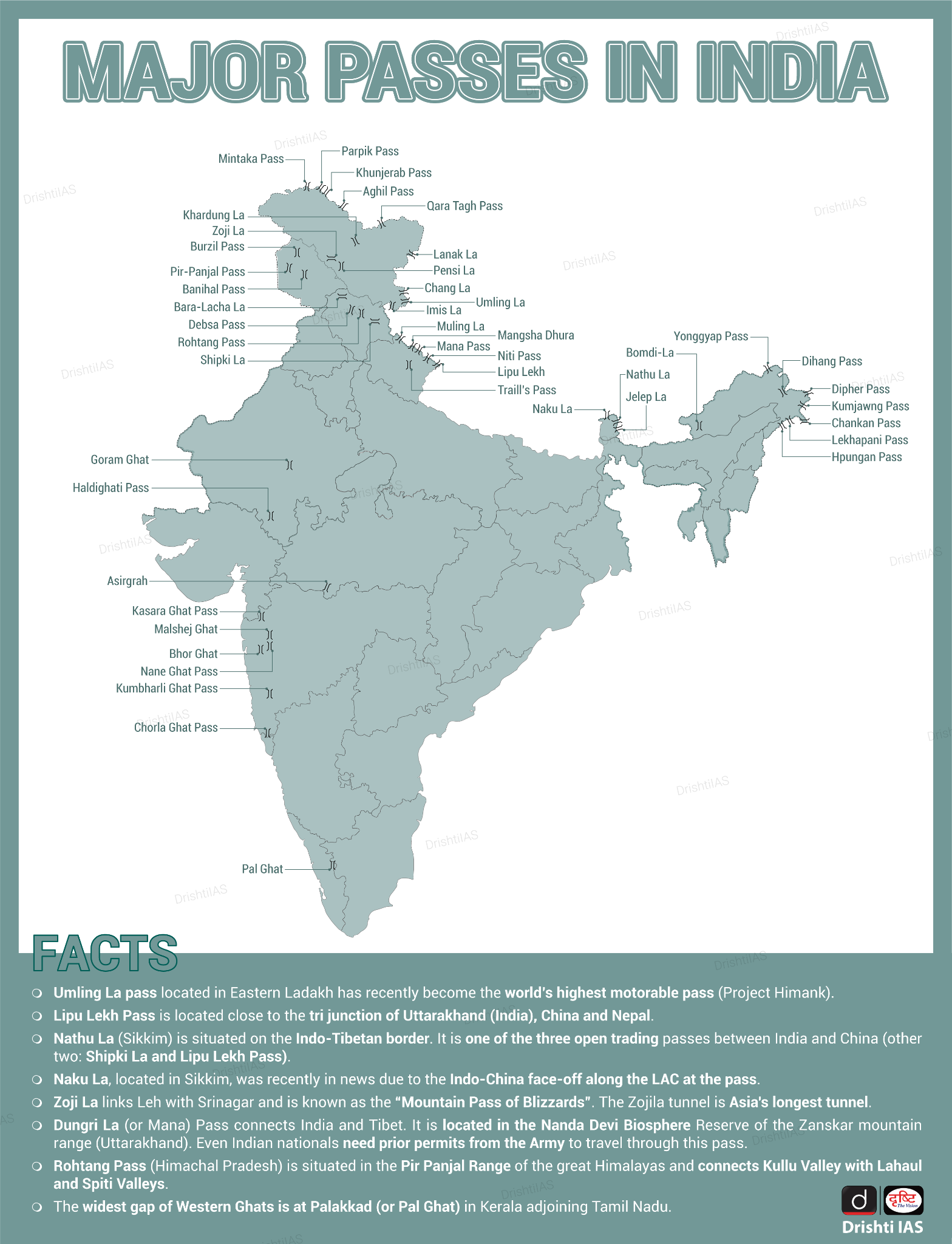UNEP Foresight Report 2024
For Prelims: UNEP Foresight Report 2024, UN SDG Goals, United Nations, Global Warming, Forced Displacement, Climate Change, UNEP, UNEA.
For Mains: UNEP Foresight Report 2024, Highlights, Significance etc.
Why in News?
Recently, the United Nations Environment Programme (UNEP) released a report titled "Navigating New Horizons: A Global Foresight Report on Planetary Health and Human Wellbeing, 2024.
- The report urges the world to address emerging challenges that could disrupt planetary health. It highlights 8 critical global shifts accelerating the triple planetary crisis of climate change, biodiversity loss, nature loss, and pollution.
What are the Key Highlights of the Report?
- No Significant Progress in UN SDG Goals: 85% of the 169 SDG targets are off track and 37% of the targets have shown no progress or have regressed since 2015, as of the latest 2023 SDG Progress Report.
-
42.85% of the targets for SDG 6 (Clean Water and Sanitation), SDG 13 (Climate Action), SDG 14 (Life Below Water), and SDG 15 (Life on Land) are either stagnating or regressing.
- 60% of environmental indicators remain either deteriorating or unclear in their status.
-
- 8 Shifts, 18 Signals of Change: The UNEP report identified 8 critical shifts with 18 potential signals of change.
- These signals are not inherently good or bad, but are early signs of potential future developments and could have a big impact on the future if they do happen.
- Rapidly Changing Relationship Between Humans and Environment: Human activities are predicted to affect over 90% of land by 2050. Up to 46% of species may face extinction.
- Global temperatures are projected to rise 2.1-3.9°C by 2100.
- Greenhouse gas emissions, mainly from fossil fuels, are driving these changes, with developed nations responsible for most emissions.
- Scarcity and Competition for Critical Resources: The global competition for critical resources is reshaping international security. Demand outpaces supply, amplifying volatility and potential conflicts, especially in regions with concentrated reserves.
- The most fundamental resources, water and food, face growing threats from climate change and unsustainable management, disproportionately affecting vulnerable populations.
- The projected growth in demand for critical minerals in 2050 to achieve net zero emissions is given below:
- AI, Digital Transformation and Technology: The key drivers of rapid advancement of digital technologies and AI include mobile devices, internet access, and the growth of AI that offer prospects for progress, their environmental implications require consideration.
- There are over 8.89 billion mobile subscriptions, with around 5.6 billion users owning a device. As per ITU reports, 67.4% of the world's population were internet users in 2023.
- A New Era of Conflict: The report warns that AI-based and autonomous weapons could cause major global disruptions in 4-6 years without human oversight.
- Experts believe there is a high likelihood (59%) of such disruptions occurring, with a high perceived intensity of impact.
- Examples include the Ukrainian military using AI-equipped drones to strike Russian targets in the Russia-Ukraine war, and the risk of AI-controlled bioweapons.
- Mass Forced Displacement: The report reveals that 1.5% of the global population is forcibly displaced, nearly double the number from a decade ago.
- Climate change is a major driver, with extreme conditions like wildfires, flooding, poor air quality, and intolerable heat contributing significantly.
- Africa, Central America, Pacific Islands, and South Asia face higher risks of climate-induced migration and displacement.
- By 2070, 3 billion people could live outside suitable climate conditions if no mitigation occurs and environmental migrants could be 25 million-1 billion by 2050.
- Internally displaced persons have increased by 340% in 20 years, with climate-related disasters now displacing more people than conflicts.
- Widening Inequalities: The report highlighted that global inequality is worsening, with the top 10% holding over 75% of wealth, while the bottom 50% own just 2%.
- Inequality within nations is driven by unequal access to education, jobs, and services, as well as globalisation.
- Wealth inequality also leads to ecological inequities, as the wealthy drive climate change, while the poor face the greatest environmental harm.
- Misinformation, Declining Trust and Polarisation: The erosion of trust in science and public institutions has undermined evidence-based policymaking and democratic governance.
- This decline in trust, from perceived failures and 'fake news', makes it harder to implement effective policies to address challenges like the climate crisis.
What are the Future Outlook and Recommendations of UNEP?
- Broadening Stakeholder Engagement: Actively involve a diverse range of stakeholders, including women, indigenous groups, and young people, using technological and social innovations to enhance public participation, combat misinformation, and build trust.
- Stronger Voice for Young People: Ensure young people have a significant role in decision-making at all governance levels to achieve intra- and inter-generational equity.
- Redefining Progress Beyond GDP: Incorporate broader indicators of human and environmental well-being, such as the Inclusive Wealth Index and Multidimensional Vulnerability Index, to guide investments towards Sustainable Development Goals.
- Community Empowerment: Promote agile and adaptive governance that empowers communities to experiment, innovate, and share knowledge, while setting flexible long-term environmental goals and targets.
- Data-Driven Decision-Making: Leverage data, monitoring, and knowledge-sharing platforms to inform evidence-based policymaking across sectors and scales, enhancing environmental monitoring from local to global levels.
- Sustainable Prosperity: Transform economies and societies to achieve prosperity within environmental limits, guided by shared values of equity, sustainability, and resilience, and reimagine the role of businesses, markets, and governance to prioritise people and the planet.
What is UNEP?
- The UNEP is a leading global environmental authority established on 5th June 1972.
- It sets the global environmental agenda, promotes sustainable development within the United Nations system, and serves as an authoritative advocate for global environment protection.
- Major Reports: Emission Gap Report, Adaptation Gap Report, Global Environment Outlook, Frontiers, Invest into Healthy Planet.
- Major Campaigns: Beat Pollution, UN75, World Environment Day, Wild for Life.
- Headquarters: Nairobi, Kenya.
|
Drishti Mains Question: How has the evolving human-environment relationship impacted global SDG progress? Analyse the implications of this relationship for global progress and propose innovative strategies for a sustainable future. |
UPSC Civil Services Examination Previous Year Question
Prelims
Q. The ‘Common Carbon Metric’, supported by UNEP, has been developed for
(a) assessing the carbon footprint of building operations around the world
(b) enabling commercial fanning entities around the world to enter carbon emission trading
(c) enabling governments to assess the overall carbon footprint caused by their countries
(d) assessing the overall carbon foot-print caused by the use of fossil fuels by the world in a unit time
Ans: (a)
Mains
Q. Discuss global warming and mention its effects on the global climate. Explain the control measures to bring down the level of greenhouse gases which cause global warming, in the light of the Kyoto Protocol, 1997. (2022)
Shadow Cabinets in Parliamentary Democracies
For Prelims: Shadow Cabinet, Leader of the Opposition (LoP), Kitchen Cabinet, Parliament
For Mains: Shadow cabinets in India, Checks & Balances
Why in News?
Recently, the leader of the Opposition (LoP) and president of Biju Janata Dal (BJD), has formed a 'shadow cabinet' comprising 50 BJD Members of the Legislative Assembly (MLAs) in Odisha.
- This development comes in the wake of the Bharatiya Janata Party's recent electoral successes in the state and marks a significant shift in legislative dynamics.
What is a Shadow Cabinet?
- About: A shadow cabinet consists of opposition MLAs/MPs who mirror the portfolios of government ministers. Led by the LoP, the shadow cabinet monitors and critiques the actions of the ruling government across various departments and ministries.
- In parliamentary democracies around the world, the concept of a shadow cabinet plays a pivotal role in the dynamics of governance and opposition.
- Originating from the Westminster system and prominently used in countries like the United Kingdom, Australia, Canada, and New Zealand, the concept of a shadow cabinet offers a structured framework for opposition MPs to scrutinise and challenge the policies of the ruling government.
- Benefits:
- By shadowing specific ministries, MPs gain in-depth knowledge and expertise, enabling them to effectively challenge government policies during parliamentary debates.
- It provides an opportunity for opposition MPs to gain leadership experience, preparing them for future ministerial roles based on their performance in the shadow cabinet.
- Strengthens parliamentary democracy by ensuring robust scrutiny of executive actions and fostering informed debates on public policies.
- By presenting a credible alternative to government policies, the shadow cabinet ensures that decisions are thoroughly debated and scrutinised, preventing hasty or arbitrary legislative actions.
- Challenges and Criticisms:
- In India's multi-party system, coordinating a unified shadow cabinet poses challenges due to differing party priorities and ideologies.
- Critics argue that focusing on specific ministries may limit MPs' holistic understanding of governance issues. However, proponents assert that periodic reshuffles within the shadow cabinet can address this concern.
- Despite being a statutory position, recognition of the LoP and institutionalisation of shadow cabinets can vary, impacting their effectiveness across different parliamentary sessions.
- Potential Implications for Indian Democracy:
- Institutionalising a shadow cabinet can fortify parliamentary oversight mechanisms, ensuring that all legislative actions are thoroughly debated and justified.
- By presenting coherent policy alternatives, the shadow cabinet can enhance public trust in parliamentary proceedings, showcasing opposition parties as credible alternatives to governance.
- Encouraging a shift from personality-driven politics to policy-focused debates, a shadow cabinet promotes a more substantive discourse on governance and public policy.
- Institutionalising a shadow cabinet can fortify parliamentary oversight mechanisms, ensuring that all legislative actions are thoroughly debated and justified.
- International Examples:
- United Kingdom: The Shadow Cabinet is appointed by the Leader of the Opposition to mirror the Government's Cabinet.
- Each member leads on a specific policy area for their party and questions and challenges their counterpart in the Cabinet, presenting the Official Opposition as an alternative government-in-waiting.
- Canada: The opposition parties form shadow cabinets, groups of opposition MPs, called critics, who are responsible for the same areas of expertise as the governing party’s Cabinet ministers.
- Having them sit in a mirror image of each other is a reminder that one side can potentially replace the other at any time.
- United Kingdom: The Shadow Cabinet is appointed by the Leader of the Opposition to mirror the Government's Cabinet.
Experiments with Shadow Cabinets in India
- Maharashtra, 2005 BJP-Shiv Sena Shadow Cabinet:
- Formed to counter the Congress-NCP government.
- Composition: Included key opposition leaders from BJP and Shiv Sena, shadowing respective government ministries.
- Impact: Provided structured oppositional scrutiny and policy critiques in the state assembly.
- Madhya Pradesh, 2014 Congress Shadow Cabinet:
- Composition: Involved senior Congress leaders and legislators, shadowing government departments.
- Outcome: Enhanced opposition visibility and accountability in state legislative proceedings.
- Goa, 2015 NGO-led Shadow Cabinet
- Introduced by Gen Next, a non-governmental organisation. Analysed policies of the ruling government, despite not being an official opposition entity.
- Provided independent scrutiny and public discourse on governance issues.
- Kerala, 2018 Civil Society Shadow Cabinet:
- Led by civil society members to scrutinise policies. Included social activists and experts, not affiliated with the opposition UDF.
- Impact: Offered critical analysis and alternative perspectives on government policies and initiatives.
Note: The 'inner Cabinet' or 'Kitchen Cabinet' is a smaller informal group consisting of the Prime Minister and two to four trusted colleagues, who hold the true seat of power.
Way Forward
- Formalisation: While not mandated by law, the Parliament could amend its rules to formally recognise the LoP and grant them the right to appoint a shadow cabinet.
- This would elevate the status of the opposition and provide a framework for their operations.
- In the long term, consider amending the Constitution to formally recognise the Leader of the Opposition and the shadow cabinet.
- Research Funding: Parliament could allocate a budget for research staff and resources specifically for the shadow cabinet. This would empower them to analyse government policies more effectively and develop informed alternatives.
- Selection of Shadow Ministers: The LoP should appoint shadow ministers based on their expertise, experience, and qualifications in relevant policy areas. This ensures that the shadow cabinet is composed of individuals capable of providing informed and constructive criticism.
|
Drishti Mains Question: Q. Discuss the concept of a shadow cabinet and its role in parliamentary democracies. How does it function as an alternative to the ruling government's cabinet? |
UPSC Civil Services Examination, Previous Year Question (PYQ)
Prelims:
Q. Which of the following is/are the function/functions of the Cabinet Secretariat? (2014)
- Preparation of agenda for Cabinet Meetings
- Secretarial assistance to Cabinet Committees
- Allocation of Financial resources to the Ministries
Select the correct answer using the code given below:
(a) 1 only
(b) 2 and 3 only
(c) 1 and 2 only
(d) 1, 2 and 3
Ans: (c)
Mains:
Q. To what extent, in your view, the Parliament is able to ensure accountability of the executive in India? (2021)
Collapse of Multiple Infrastructures
For Prelims: Corruption Perceptions Index (CPI), Morbi Bridge, Members of Parliament Local Area Development Scheme (MPLAD), Covid-19, PM Gati Shakti Scheme, Bharatmala scheme, IIPDF (India Infrastructure Project Development Fund) Portal
For Mains: Building Resilient Infrastructure for Development and Disaster Mangement.
Why in News?
Recently, several physical infrastructures, like bridges in Bihar and airport canopy structures in Delhi and Rajkot of Gujarat collapsed.
What are the Causes of the Collapse of Physical Infrastructures?
- Natural causes:
- Heavy Rainfall: Prolonged and intense rainfall can saturate the soil and increase the weight of bridge structures, leading to potential failures.
- Incase of Bihar, significant water flow from upstream Nepal has also contributed to the factor.
- Disasters: Disasters like earthquakes can cause weakening of infrastructure.
- Heavy Rainfall: Prolonged and intense rainfall can saturate the soil and increase the weight of bridge structures, leading to potential failures.
- Administrative Causes:
- Corruption: Corruption in administration and tender allocation causes administrative failures related to the implementation and monitoring of projects.
- For example- India ranked 93 out of 180 countries on the Corruption Perceptions Index (CPI) for 2023.
- Management issue: Lack of proper maintenance, monitoring and management of crowds leads to infrastructure failure.
- For example: One of the reasons for the collapse of the Morbi Bridge was failure in regular maintenance and crowd management.
- Corruption: Corruption in administration and tender allocation causes administrative failures related to the implementation and monitoring of projects.
- Procedural Causes:
- Failure to Follow Design Protocols: Deviations from established engineering designs and safety protocols can lead to structural vulnerabilities.
- Poor Quality Control: Lack of inspections and insufficient quality control measures during construction can result in undetected flaws that compromise safety.
- The use of inferior materials can significantly weaken structural integrity, reducing the capacity to bear environmental stresses.
Which are Schemes for Building Rural Infrastructure?
-
Member of Legislative Assembly Local Area Development Scheme (MLALAD):
- It is the state’s version of a central government scheme- MPLAD.
- The objective of this scheme is to create local need-based infrastructure, to create assets of public utility and to remove regional imbalances in development.
- The MLALAD programme provides funding for each constituency directly from the state government.
- While MLAs and MPs do not directly receive the funds, they can recommend projects for the scheme.
- The projects funded by them are usually restricted to “durable infrastructure work”, from repairing roads to building community centres.
- The funds have also been used for natural disaster relief in some states, as in the case of Covid-19.
- Pradhan Mantri Gram Sadak Yojana:
- It was launched in 2000 to provide connectivity, by way of an all-weather road to unconnected habitations.
- Eligibility: Unconnected habitations of designated population size (500+ in plain areas and 250+ in North-Eastern States, Himalayan States, Deserts and Tribal Areas as per 2001 census) in the core network for uplifting the socio-economic condition of the rural population
- Latest Funding Pattern: The Union Government bears 90% of the project cost in respect of projects sanctioned under the scheme in North-Eastern and Himalayan States, whereas for other states the Union Government bears 60% of the cost.
Other Major Initiatives for Building Physical Infrastructure
Way Forward
- Administrative Reforms: It will ensure better monitoring and implementation of projects with a transparent system.
- Adopting Modern Engineering Practices: Utilise advanced design techniques and materials that enhance durability.
- Public-Private Partnerships (PPPs): Encourage collaboration between government and private sector for funding and expertise to bring more investments.
- Strict Regulatory Standards: Implement rigorous standards for materials and construction practices.
- Regular Inspections: Conduct frequent assessments to ensure compliance with safety and quality benchmarks.
- Resilience Planning: Design infrastructure to withstand climate change impacts and natural disasters.
- Capacity Building: Invest in training programs for engineers, architects, and construction workers to enhance skills.
|
Drishti Mains Question: Q. Assess the role of infrastructure development in achieving sustainable economic growth in India. What are the key challenges faced in this sector? |
UPSC Civil Services Examination, Previous Year Question (PYQ)
Mains:
Q. “Investment in infrastructure is essential for more rapid and inclusive economic growth.” Discuss in the light of India’s experience. (2021)
WHO and UNICEF Estimates of National Immunisation Coverage (WUENIC)
Why in News?
Recently released WHO and UNICEF estimates of national immunisation coverage (WUENIC) revealed a slight dip in childhood immunisation in 2023 compared to 2022.
- In another development, a quiet digital revolution is unfolding as part of the government’s pilot project to register pregnant women and children on U-Win.
What are the Key Highlights of the WUENIC?
- About:
- Each year, WHO and UNICEF jointly review reports submitted by Member States regarding national immunisation coverage, finalized survey reports, and data from published and grey literature.
- Major Findings:
- Immunisation was stalled globally in 2023, leaving 2.7 million additional children either unvaccinated or under-vaccinated, as compared to the pre-pandemic year of 2019.
- It reveals a slight dip in childhood immunisation in India in 2023 compared to 2022.
- There was a two percentage point dip (from 95% in 2022 to 93% in 2023) in the coverage of diphtheria, pertussis, and tetanus (DPT) vaccines, used as a proxy for the number of “zero-dose” children.
- Zero-dose children are those who have not received any routine immunisation.
- It shows that there were 1.6 million zero-dose children in India in 2023, up from 1.1 million in 2022, but much less than 2.73 million seen in 2021.
- In 2023, 91% received the third DPT vaccine dose, down 2% from 2022 but still above the global average of 84%.
- In absolute terms, 2.04 million children remained under-vaccinated in 2023, slightly lower than the 2.11 million children in 2019.
What is U-Win?
- About:
- U-WIN, the initiative aimed at digitising India's Universal Immunisation Programme (UIP), has been rolled out in a pilot phase.
- Following the success of the Co-WIN platform, the government has established an electronic registry for routine vaccinations.
- U-WIN, the initiative aimed at digitising India's Universal Immunisation Programme (UIP), has been rolled out in a pilot phase.
- Objective:
-
The platform will be used to register and vaccinate every pregnant woman, record her delivery outcome, register every newborn delivery, administer birth doses and all vaccination events thereafter.
- The U-WIN is going to be the single source of information for immunisation services, updating vaccination status, delivery outcome, and reports like antigen-wise coverage, etc.
-
- Benefits:
- Healthcare workers and programme managers will be able to generate real-time data on routine immunisation sessions and vaccination coverage for better planning and vaccine distribution.
- For pregnant women and children, vaccine acknowledgement and immunisation cards linked to ABHA ID (Ayushman Bharat Heath Account) will be generated and all states and districts can access a common database to track and vaccinate beneficiaries.
- Upon complete digitisation of the immunization programme, beneficiaries will receive instant certificates which can also be downloaded and stored in digi-lockers.
- An effective surveillance system will help create an evidence base to enable the planning and deployment of effective interventions.
UPSC Civil Services Examination, Previous Year Question (PYQ)
Prelims:
Q1. Which of the following are the objectives of ‘National Nutrition Mission’? (2017)
- To create awareness relating to malnutrition among pregnant women and lactating mothers.
- To reduce the incidence of anaemia among young children, adolescent girls and women.
- To promote the consumption of millets, coarse cereals and unpolished rice.
- To promote the consumption of poultry eggs.
Select the correct answer using the code given below:
(a) 1 and 2 only
(b) 1, 2 and 3 only
(c) 1, 2 and 4 only
(d) 3 and 4 only
Ans: (a)
Q2. Which of the following gives ‘Global Gender Gap Index’ ranking to the countries of the world? (2017)
(a) World Economic Forum
(b) UN Human Rights Council
(c) UN Women
(d) World Health Organization
Ans: (a)
Mains
Q. “Besides being a moral imperative of a Welfare State, primary health structure is a necessary precondition for sustainable development.” Analyse. (2021)
Caves on the Moon
Why in News?
Recently, scientists have confirmed the existence of a cave on the moon, located near the site where the Apollo 11 mission landed 55 years ago.
- This discovery has significant implications for future lunar exploration and the establishment of a sustainable human presence on the moon.
What are the Key Findings Related to the Moon?
- Key Findings:
- An Italian-led team of researchers found evidence of a cave located in the Sea of Tranquility, just 400 kilometres from the Apollo 11 landing site.
- The pit, like more than 200 others discovered on the lunar surface, was created by the collapse of a lava tube.
- Analysis of radar measurements by NASA's Lunar Reconnaissance Orbiter revealed that the cave is at least 40 meters wide and tens of meters long, and likely even larger.
- An Italian-led team of researchers found evidence of a cave located in the Sea of Tranquility, just 400 kilometres from the Apollo 11 landing site.
- Significance/Implications:
- Potential Shelter for Future Astronauts: Lunar caves offer natural protection against cosmic rays, solar radiation, and micrometeorites, reducing the need for constructing habitats from scratch.
- Understanding Lunar Geology and Volcanic Activity: The rocks and materials inside these caves, which have remained largely unaltered by the surface conditions over the eons.
- It can help scientists better understand the evolution of the moon, particularly its volcanic activity
- Potential Water and Fuel Sources: Permanently shadowed craters near the lunar south pole likely contain frozen water, a crucial resource for drinking and rocket fuel.
- Advancing Lunar Exploration: Discovering lunar caves is a major step in understanding the moon's geology and resources, aiding future mission planning and the sustainability of human presence on the moon.
Moon Exploration
- In 1959, the Soviet Union's Luna 1 and 2 were the first robotic missions to visit the Moon.
- The USA sent 3 classes of robotic missions to the Moon between 1961 and 1968 before the Apollo 11 mission.
- From 1969 to 1972, 12 American astronauts walked on the Moon's surface.
- In the 1990s, the USA resumed lunar exploration with robotic missions like Clementine and Lunar Prospector.
- In 2009, the USA launched the Lunar Reconnaissance Orbiter (LRO) and the Lunar Crater Observation and Sensing Satellite (LCROSS) for lunar missions.
- In 2011, NASA began the ARTEMIS mission for lunar exploration.
- The Gravity Recovery and Interior Laboratory (GRAIL) spacecraft studied the Moon's gravity in 2012.
- China landed two rovers on the Moon's surface, including the first-ever landing on the far side of the Moon in 2019.
India’s (ISRO) Moon Mission
- Chandrayaan 1: The Chandrayaan project started in 2007 through a collaboration between ISRO and Russia's ROSCOSMOS. The mission was initially postponed to 2016 due to delays in developing the lander by Russia.
- Findings: The confirmed presence of lunar water, evidence of lunar caves, and past tectonic activity on the lunar surface.
- Chandrayaan-2 is India's second moon mission, consisting of an Orbiter, Lander (Vikram), and Rover (Pragyan). The Rover Pragyan is housed inside the Vikram lander.
- Chandrayaan-3: Through this India made history by becoming the first country to land near the lunar south pole and ISRO became the fourth space agency to successfully land on the Moon, following Roscosmos, NASA, and the CNSA.
UPSC Civil Services Examination, Previous Year Question (PYQ)
Prelims:
Q. Consider the following statements: (2016)
- The Mangalyaan launched by ISRO
- is also called the Mars Orbiter Mission
- made India the second country to have a spacecraft orbit the Mars after USA
- made India the only country to be successful in making its spacecraft orbit the Mars in its very first attempt
Which of the statements given above is/are correct?
(a) 1 only
(b) 2 and 3 only
(c) 1 and 3 only
(d) 1, 2 and 3
Ans: C
Mains:
Q. Discuss India’s achievements in the field of Space Science and Technology. How the application of this technology helped India in its socio-economic development? (2016)
Last Universal Common Ancestor (LUCA)
Why in News?
Recently, in a new study, scientists have said the last universal common ancestor (LUCA) could have formed just 300 million years after the earth formed.
What are the Recent Key Highlights of the Research?
- About:
- Researchers believe all three branches of life namely bacteria, archaea, and eukarya originated from a single cell, called the last universal common ancestor (LUCA).
- LUCA had a small genome with about 2.5 million bases and 2,600 proteins, sufficient for survival in its unique environment.
- LUCA's metabolites might have created a secondary ecosystem for other microbes to emerge, and it possibly had immunity genes to fight off viruses.
- Though there is no fossil evidence to support the existence of LUCA, modern genomes share so many features that provide some insights.
- However, the theory of the molecular clock allowed scientists to reconstruct the ‘tree of life’.
- As per theory, the rate at which mutations are added or removed from a population’s genome is proportional to the rate of acquiring new mutations, which is constant.
- The mutation rate varies between species.
- Based on the findings, researchers created a method to estimate the time between evolutionary events by using known mutation rates and linking genomes to specific events like the evolution of the first mammal or the age of fossils as benchmarks.
- As per theory, the rate at which mutations are added or removed from a population’s genome is proportional to the rate of acquiring new mutations, which is constant.
- Based on the earlier findings of fossils in the Pilbara Craton in Australia, the earliest life forms were believed to be date back to 3.4 billion years ago.
- Significance of Findings:
- Overall, these findings are crucial for understanding how life began and evolved on Earth and for seeking similar life forms elsewhere in the universe.
- These evolutionary insights will boost efforts to engineer synthetic organisms for various processes on Earth and to create or manage ecosystems on other planets in the future.
What are Various Competing Theories of Life's Origin?
- Oparin-Haldane Hypothesis: In 1924 and 1929, Oparin and Haldane respectively suggested the first molecules making up the earliest life forms gradually self-organised from a “primordial soup” in a young earth’s tempestuous, prebiotic environment. This idea is today called the Oparin-Haldane hypothesis.
- Miller-Urey Experiment: It showed that in the right conditions, inorganic compounds could give rise to complex organic compounds.
- Under it methane, ammonia, and water were mixed and applied an electric current to produce amino acids, the building blocks of proteins.
- Panspermia Hypothesis: It suggests that meteorites could have brought life's building blocks to Earth, supported by discoveries of extraterrestrial organic material and amino acids on asteroids.
Read More: Earth’s Mantle and Evolution of Life
UPSC Civil Services Examination, Previous Year Question (PYQ)
Prelims:
Q. Consider the following: (2013)
- Electromagnetic radiation
- Geothermal energy
- Gravitational force
- Plate movements
- Rotation of the earth
- Revolution of the earth
Which of the above are responsible for bringing dynamic changes on the surface of the earth?
(a) 1, 2, 3 and 4 only
(b) 1, 3, 5 and 6 only
(c) 2, 4, 5 and 6 only
(d) 1, 2, 3, 4, 5 and 6
Ans: (d)
Q. Which one of the following sets of elements was primarily responsible for the origin of life on the Earth? (2012)
(a) Hydrogen, Oxygen, Sodium
(b) Carbon, Hydrogen, Nitrogen
(c) Oxygen, Calcium, Phosphorus
(d) Carbon, Hydrogen, Potassium
Ans: (b)
E-Office Implementation in Government Bodies
The Indian government has announced that the e-office platform will be implemented across all attached, subordinate offices and autonomous bodies as part of the 100-day agenda of the Department of Administrative Reforms and Public Grievances (DARPG).
- The e-office initiative aims to digitise file handling and receipts across various government bodies. This move follows the successful adoption of the e-office in the central secretariat between 2019 and 2024, where 94% of files and 95% of receipts were handled electronically.
- Building on this success, the government has identified 133 entities for this initiative, following inter-ministerial consultations. Guidelines for the adoption were by DARPG, and the National Informatics Centre (NIC).
- Each ministry and department will appoint nodal officers, establish data centres, and coordinate with NIC for a seamless, time-bound onboarding of the e-office system, reinforcing the government's commitment to digital transformation and administrative efficiency.
Read more: E- Governance in India
Drone Test at World’s Highest Pass
Recently, a Bengaluru firm, NewSpace Research and Technologies tested a 100-kg Max Takeoff Weight (MTOW) Unmanned Aerial Vehicle (UAV) at 19,024 feet altitude at Ladakh’s Umling La pass, the highest motorable pass in the world.
- According to the firm, this is a new world record for high altitude operations achieved by a 100-kg MTOW class drone.
- It will greatly improve support logistics, disaster and rescue operations, and medical relief in the mountainous regions of J&K, Uttarakhand, and the North Eastern states.
- Umling La pass:
- Umling La in Ladakh is the world's highest motorable road at 19,024 ft, constructed by the Border Road Organization as part of "Project Himank".
- The 52-km road connects Chishumle to Demchok villages, which are near the Line of Actual Control (LAC) and a friction point between India and China.
Read More: Air-Launched Unmanned Aerial Vehicle
Indian Aid to Palestinian Refugees
Recently, India has released the first tranche of USD 2.5 million to the United Nations Relief and Works Agency (UNRWA) for Palestinian Refugees in the Near East as part of its annual contribution of USD 5 million for the year 2024-25.
- UNRWA has been carrying out direct relief and work programmes for registered Palestinian refugees since 1950 and is making efforts to continue functioning amidst the Israel-Hamas war in Gaza.
- India has provided financial support of USD 35 million till 2023-24 for UNRWA's core programmes and services, including education, healthcare, relief, and social services for Palestinian refugees.
United Nations Relief and Works Agency (UNRWA):
- It was established in 1949 by the UN General Assembly after the 1948 Arab-Israeli war.
- Its mandate is to provide aid and protection to Palestinian refugees who were displaced following the 1948 Arab-Israeli conflict, as well as their descendants.
- It operates in Gaza, the West Bank, Lebanon, Syria, and Jordan.
- It is funded almost entirely by voluntary contributions from UN member states.
- India's support to UNRWA includes financial assistance as well as providing medicines based on the agency's specific request.
Read more: Israel-Hamas Conflict and its Global Impact
Operation Nanhe Faristey
Over the past seven years (2018- May 2024), the Railway Protection Force (RPF) has been at the forefront of an operation named 'Nanhe Faristey' a mission dedicated to rescuing children in need of care and protection across various Indian Railway Zones.
- During this period, the RPF has rescued more than 84,000 children who were at risk in stations and trains, preventing them from falling into harm's way.
- Track Child Portal contains comprehensive details about aggrieved children. Indian Railway has established child help desks at over 135 railway stations.
- When a child is rescued by the RPF, they are handed over to the District Child Welfare Committee which hands over the child to parents.
- The RPF is an armed force under the control of the Union Ministry of Railways, tasked with protecting railway property, passenger areas, and passengers.
- Originally part of the Watch and Ward set-up of Private Railway Companies in 1881, it was reorganised into a statutory body under the RPF Act, 1957.
- The post-independence era brought significant changes; the Railway Property (Unlawful Possession) Act was passed in 1966 to improve security, and in 1985, the RPF Act was amended, making RPF an Armed Force and emerged as a Central Police Organization.
Read More: Operations of Railway Protection Force
4th Periodic Review of the ICCPR
India successfully concluded its 4th periodic review by the Human Rights Committee under the International Covenant on Civil and Political Rights (ICCPR) in Geneva.
- The ICCPR is an important international human rights treaty that, along with other key documents, forms the International Bill of Human Rights. It obligates countries to protect and preserve basic human rights such as the right to life, freedom of speech, and gender equality.
- Adopted by the UN General Assembly in 1966, ICCPR came into force in 1976 and has been ratified by 173 countries including India in 1979, undergone three previous reviews, with the latest in 2024.
- The 4th periodic review covered diverse issues including anti-corruption measures, non-discrimination, women's and minority rights, counter-terrorism, judicial framework , and privacy laws.
- Other main UN International Human Rights Conventions and Protocols that India is a part of include:
Read more: Protesting is a Fundamental Right: UN

